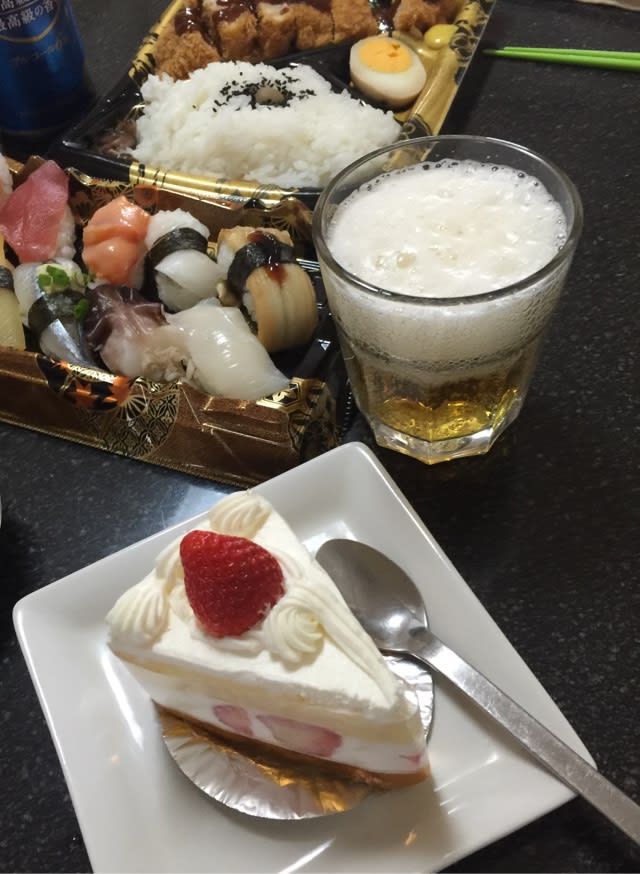 私の職場には、諸先輩および同年代の同僚(男子4名、女子1名)が、62歳までに相次いでご逝去され「62歳には気をつけろ」とささやかれてきました。5月半ばを過ぎて、私はどうにか「62歳の壁」を超えることができました。丈夫な身体に産んでくれた母に感謝です。母は64歳、義父も64歳で他界していますので、次は「64歳の壁」を超え、89歳で他界した父を超えることが、私なりの親孝行だと思い、心身の鍛錬に心がけたいとおもいます。
私の職場には、諸先輩および同年代の同僚(男子4名、女子1名)が、62歳までに相次いでご逝去され「62歳には気をつけろ」とささやかれてきました。5月半ばを過ぎて、私はどうにか「62歳の壁」を超えることができました。丈夫な身体に産んでくれた母に感謝です。母は64歳、義父も64歳で他界していますので、次は「64歳の壁」を超え、89歳で他界した父を超えることが、私なりの親孝行だと思い、心身の鍛錬に心がけたいとおもいます。
 【454~455ページ】《明治32年》抜粋
【454~455ページ】《明治32年》抜粋(春)
・手に満つる蜆(しじみ)うれしや友を呼ぶ
・灯暗く蛙(かはづ)きく夜や写し物
(夏)
・葭簀(よしず)して囲ふ流れや冷瓜
(冬)
・釈迦に問(とう)て見たき事あり冬籠(ふゆごもり)
【435~436ページ】《明治33年》抜粋
(新年)
・長病(ながやみ)の今年も参る雑煮哉
・初曽我や団十菊五左団小団
(夏)
・夕立や蛙の面に三粒程
(秋)
・冬近く今年は髭を蓄へし
【458~459ページ】《明治34年》抜粋
(春)
・木の芽ふく十坪の庭を散歩かな
(欲睡)
・秋の蝿叩き殺せと命じけり
(病床所見)
・病閑(やまいかん)に糸瓜の花の落つる昼
(冬)
・蘭学の書生なりけり薬喰(くすりくい)
[ken] 三句について感想を述べさせていただきます。「手に満つる蜆(しじみ)うれしや友を呼ぶ」は、情景が目に浮かんでくるようです。いただいたものか、買い求めたものかは判別しがたいですが、手の中に余るほどの蜆を前に、友人を呼んで一緒に食べようという日常の小さな楽しみを、サラリと一句にしています。
「夕立や蛙の面に三粒程」では、蛙の観察をとおして自分も夕立によって、夏の暑さを紛らわしている瞬間が実に見事ですね。
一方、「秋の蝿叩き殺せと命じけり」では病床での苛立ちが、強い命令の語調となっています。正岡子規さんが、蠅に対して厳しかったのは、蠅を病魔と同様に感じたからなのでしょうか。近くへ飛んで行った蠅に悪気はないのですが、相手を間違えたのですね。(つづく)
 ▼私はお裁縫が好きです。完全に仕事をリタイアしたら、綿入れ半纏や浴衣、相撲甚句用の半纏ぐらいは縫ってみたいと思っています。
▼私はお裁縫が好きです。完全に仕事をリタイアしたら、綿入れ半纏や浴衣、相撲甚句用の半纏ぐらいは縫ってみたいと思っています。I like sewing When I completely retire from work, I would like to sew cotton-filled hanten, yukata, and hanten for sumo wrestlers.
 ▼先日、平和祈念イベントに使う千羽鶴作りのお手伝いをしました。糸を通して、先端を持った糸を指でパチンとはじき、まとわりつかないように糸をまっすぐにする、このルーティンが好きです。
▼先日、平和祈念イベントに使う千羽鶴作りのお手伝いをしました。糸を通して、先端を持った糸を指でパチンとはじき、まとわりつかないように糸をまっすぐにする、このルーティンが好きです。The other day, I helped make a thousand paper cranes for a peace event.
I love this routine of threading a needle and snapping the thread with the tip to straighten the thread so it doesn't cling.
 ▼針と糸を手にすると、私は心が落ち着きます。なんとも心苦しいような、くすぐったいような思いをしながら、折り鶴の尻から針を差し込み、背中に突き通し、頭と尻尾を前の折り鶴に挟み込んでいきます。
▼針と糸を手にすると、私は心が落ち着きます。なんとも心苦しいような、くすぐったいような思いをしながら、折り鶴の尻から針を差し込み、背中に突き通し、頭と尻尾を前の折り鶴に挟み込んでいきます。With a needle and thread in my hands, I feel at peace.
With a very painful and tickling feeling, I insert the needle from the bottom of the paper crane, pierce it through the back, and tuck the head and tail into the paper crane in front of me.
 ▼中には新種の折り鶴もあって、千羽鶴の邪魔をしますが、なんとか本来の折り鶴に組み込み、帳尻を合わせることができました。
▼中には新種の折り鶴もあって、千羽鶴の邪魔をしますが、なんとか本来の折り鶴に組み込み、帳尻を合わせることができました。There was also a new kind of origami crane, which interfered with the 1,000 paper cranes, but I managed to incorporate them into the original origami cranes, and I was able to balance the balance.




